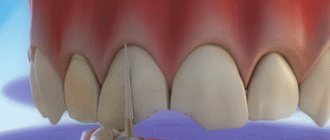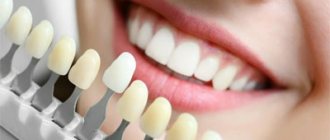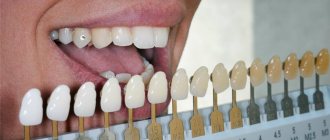A beautiful, healthy, brilliant smile is the dream of every person who cares about their health and appearance. It is much easier to correct a smile when caries, plaque and ugly, sloppy or darkened fillings are located on the side of the jaw. Those who have altered teeth along the smile line in the front, in the frontal region, face greater difficulties. In this case, it is more difficult to disguise the resulting defective changes so that everything looks as natural and inconspicuous as possible.
Fortunately, modern dentistry and aesthetic cosmetology works wonders. Veneers have become a very popular method of smile correction. Many began to wonder: is it necessary to depulpate teeth to install plates? Since the tooth for veneer is processed in the most gentle way, only the surface layer of enamel is slightly polished, so there is no need to depulp the tooth. But there are cases when, according to indications, the doctor may decide to depulpize some teeth. Much in this case depends on the qualifications of the master, his knowledge and experience.
In what cases is it permissible to place veneers on teeth that already have fillings?
The very fact of having fillings rarely becomes the reason why a dentist dissuades a patient from veneers. On the contrary, one of the cases when a person is offered veneers is if the fillings are located on the front side of the teeth and differ from natural tooth enamel in shade and texture. This becomes a quick and effective solution to an aesthetic problem.
In addition, veneers tend to protect teeth from various external influences - and along with them, fillings are also protected. A properly installed and high-quality filling under a veneer will last significantly longer - at least as long as the veneer itself will last (and the service life of ceramic veneers, for example, before they are replaced is about 10 years).
And there are even cases when the veneer itself is essentially a filling. We are talking about composite veneers. Veneers made of reflective composite material are not so durable, however, if there is a slight carious lesion on the surface of the enamel (that has not penetrated into the tooth, into the dentin), then it can be removed and not put a regular filling, but a composite veneer can be made.
How to increase the lifespan of dental veneers
Caring for veneers should begin with daily oral hygiene, especially at the junctions between the tooth and the plate. It is recommended to use an irrigator to remove food residues. To maintain a snow-white smile, it is not recommended to take products with coloring elements, as well as with high acidity.
Owners of veneers should not indulge in nuts and other dense foods. Excessive load, as a rule, leads to significant damage to the previously performed restoration. Patients with bruxism are recommended to wear a special protective mouth guard before going to bed.
But the most important way to preserve veneers for a long time is to visit your dentist regularly. The staff of the President clinics will promptly identify the problem that has arisen, offering you an effective method to eliminate it.
When is the presence of fillings a contraindication for installing veneers?
However, there is one essential point that orthodontists must clarify before starting to make impressions of teeth for veneers. This is how much area the filling occupies on the tooth. The fact is that the veneer is attached to the “living” enamel - and large fillings from the front part of the tooth under the veneer can eventually lead to its detachment or peeling off the edge.
Therefore, those cases where the filling area occupies more than two-thirds of the tooth area are considered a contraindication - an alternative to a veneer in such a situation is usually the installation of a “crown.” Please note that this applies specifically to the area of the filling, and not to its volume - after all, even deep fillings that take up a lot of volume inside the tooth may not interfere with the veneer at all if, despite their depth, they do not take up much space on the front surface of the tooth.
In addition, sometimes the dentist can dissuade the patient from installing a veneer if the tooth is not just filled, but the nerve was removed from it during treatment. The fact is that “non-living”, depulped teeth differ in strength from those in which the nerve is present: after the depulpation procedure, the tooth becomes more fragile over the years, and even preliminary grinding of the enamel for veneer may have a negative effect on it.
How are veneers different from braces?
Both veneers and braces are used to eliminate defects and make your smile beautiful. But they solve this problem in different ways:
- Veneers are permanent coverings that are attached to the surface of the tooth and remain there forever (unless there is a need to replace them). They create the necessary visual effect.
- Braces are a removable orthodontic structure whose task is to physiologically change the position of teeth in the dentition and correct the bite. Once the goal is achieved, the braces are removed.
Not in all cases, veneers are enough to eliminate the defect. For example, if a patient’s teeth are severely crooked or have an incorrect bite, it is not recommended to install veneers. In order to create the effect of an even row with their help, the teeth will have to be sharpened greatly, and this will significantly speed up their destruction. In case of such defects, it is advisable to straighten the teeth using braces.
How are filled teeth prepared for veneers?
The standard preparatory procedure that the doctor performs before gluing veneers is a fine grinding of the front surface of the teeth so that the adhesive adheres better and the veneer plate itself holds more firmly. Along with the natural enamel, the filled parts of the surface of the patient’s teeth are also polished.
However, this is only possible if the fillings are stable and if they are made of high-quality, sandable material. There are several reasons why a dentist might suggest that a patient replace old fillings in their teeth with new ones.
- If secondary caries has developed under or next to the old filling. It is impossible to “hide” carious teeth under veneers, because this will significantly complicate the process of treating them in the future - anyway, then you will have to peel off the veneer, partially or completely destroy the old filling, put a new one, then re-attach the veneer... Therefore, at the slightest suspicion of caries, it is better to start treatment straightaway.
- If the filling is made of crumbling and abrasive material. Such a material could be dental cement, which is now practically not used in dental practice, but previously, for many decades in a row, people were given cement fillings in clinics. And now, when patients come to have veneers installed, dentists have to replace these outdated fillings with better ones - for example, photopolymer ones.
- If the filling is made of metal. This is, again, a filling technology rarely used these days, but due to their amazing durability and strength, metal fillings can stay in teeth for decades. They are replaced because the metal interferes with grinding and the fixing compound for the veneer is poorly attached to it.
- If the material from which the filling is made has darkened over time. This is because veneers (and, even more so, even thinner overlays - lumineers) have a very small thickness, and the material used to create them has a certain transparency. A veneer changes the shade of a tooth: for example, it can make a yellowish tooth snow-white - but a filling under the veneer that has become very gray or brownish will ultimately give the tooth a grayish tint.
The decision about whether a veneer can be applied to a specific tooth that has a filling, and what preparatory measures may be necessary for this, should only be made by a highly qualified dentist. Sometimes a visual examination of the dentition is not enough for the doctor to make a decision - and, for example, an X-ray examination of individual teeth is required.
The specialists of the VivaDent clinic offer patients a full range of dental and orthodontic services: professional examination of the condition of teeth and fillings in them, dental treatment and initial installation or replacement of fillings, production of veneers from various materials and high-quality fixation of them on the teeth.
Thin plates for front teeth
Veneers are thin overlays, the thickness of which is 0.5 mm. They are used to restore the outer surface of teeth. The technology of using veneers itself was invented in the 30s of the last century by the American doctor Charles Pincus.
At that time, veneers were part of the costume of Hollywood stars. In order for the actors to shine in front of the camera with a dazzling snow-white smile, special plates were attached to their teeth. However, the “Hollywood smile” did not last long. Compared to their prototype, modern veneers not only look more aesthetically pleasing, but also allow you to change the appearance of your teeth.
Veneers are often used where whitening is not possible. Thin ceramic plates will help correct malocclusion, change shape and reduce unsightly gaps between teeth. Various veneering techniques are also used in combination with plastic surgery. For example, with gum surgery, with cheekbone lifting and in other cases.
Types of restorations with ceramic veneers
There are two types of porcelain veneers: pressed porcelain and porcelain-fabricated porcelain veneers. Initially, there are no special differences between the two types. The quality of structures is determined by further processing and installation.
Made from pressed ceramic
To create pressed porcelain veneers, wax modeling is first used. A model is created from special wax, according to which a ceramic plate is pressed under high pressure. On the front side of the plate, any anatomical features of the patient’s enamel are recreated. This method is good for accurately conveying the internal surface of the structure adjacent to the tooth.
Manufacturing on a refractor
When making a ceramic veneer using a refractor, special stumps are first created from a refractory mass, and then the ceramic mass is applied to them in layers. The finished structure is subsequently baked in a special oven.
Both types of ceramic veneers are offered. Regardless of the manufacturing method, ceramic onlays are always strictly individualized for the patient and installed at the highest level.
What is better - veneers or crowns?
Talking about which is better (veneers or crowns) is like comparing a car and a motorcycle. Each of these methods has its own advantages and indications for use. Below is a table that shows situations when it is most preferable to use crowns and when to use veneers.
| Indications for installation of veneers | Indications for crown installation |
|
|
By and large, crowns and veneers have different indications for installation, however, there are situations in which the patient can choose between two products.
Completely edentulous
Every modern person strives to look stylish and attractive. An important detail of any image is a beautiful and healthy smile. The absence of even one tooth can cause complexes and self-doubt; a person may become less sociable and be reluctant to make new friends. The Hollywood smile is the calling card of any public figure, with the exception of those representatives of show business who have become popular precisely because of their extraordinary appearance.
The absence of even one unit can cause the development of unpleasant complications in the near future. Therefore, experts strongly recommend closely monitoring the condition of the oral cavity and promptly seeking qualified help. Surgical intervention in case of tooth loss allows you to avoid displacement of nearby healthy neighbors, as well as restore it with the least time and financial costs. If the bone tissue has time to atrophy, a complex and lengthy procedure for its augmentation will be required.
Losing a couple of units from a row can cause problems with diction and problems with the digestive system due to the fact that it is not possible to chew food well. If a prosthesis or implant is not installed, over time, facial features will change, deep wrinkles will appear, and the skin will become less elastic. The longer a person lives without teeth, the more difficult it will be to restore his beautiful smile. Of course, a lot depends on the doctor’s qualifications, but sometimes situations arise that are so advanced that even the most experienced implantologist is powerless.
Is it possible to get veneers during pregnancy?
Oral diseases can negatively affect the health of mother and child. Therefore, every woman who registers is required to undergo a consultation with a dentist.
To make pregnancy easy, you should take care of your teeth in advance. Installing veneers is the most gentle way to transform your smile.
Modern materials for prosthetics are not capable of harming a child’s health. The components that make up the raw material do not cause allergies. But despite this, experts recommend treating teeth no later than the second trimester.
What are Lumineers?
Lumineers are a separate type of dental coverings. They differ from veneers in thickness, which does not exceed 0.2 mm, and in the installation method. Due to the thinness of the plates, in most cases they are installed without grinding the tooth enamel. Lumineers are installed if there is no need to visually correct the shape of the tooth. The main disadvantages of lumineers are:
- Low strength. It is physically impossible to provide it with a minimum thickness of 0.2 mm;
- High price. Lumineers are the most expensive type of veneers.
Veneer care
Composite and ceramic dental veneers do not require any special care, but they must be treated with care, since, like tooth enamel, these materials are relatively fragile.
If the patient had the habit of biting off hard fruits and vegetables with his front teeth - carrots, apples, etc., cracking nuts, biting off thread, he will have to give it up.
Veneers cannot be bleached, but they can be professionally cleaned. You just need to warn the doctor so that he works more delicately.
If you did not find answers to your questions about veneers in this article, ask them to our specialists during a free consultation. To make an appointment, fill out the form on the website or call us.
Advantages of ceramic veneers over composite ones
Unlike composite ones, the advantages of ceramic onlays are obvious to any specialist. And here's why: even the most expensive composite is actually plastic; it quickly loses its shine, darkens and delaminates over time. This means that composite veneers are less durable and aesthetically pleasing. Ceramic veneers, on the contrary, cannot be stained, do not change their shape, retain their relief and have the shine of natural teeth. All this makes restorations an excellent tool for creating an ideal smile, without which modern aesthetic dentistry is unthinkable. The only disadvantages of ceramic veneers are the price and complexity of installation, which require the patient to carefully approach the choice of a dental clinic.










